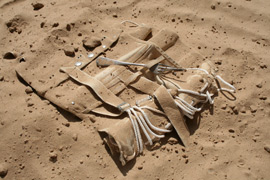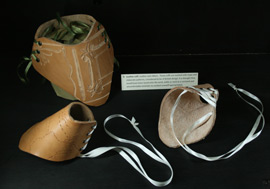Project 6 GOW at GNM
June 20th - July 16th 2011
Claire Rousell
The Lost People
Little is known about the Lost People. Few records remain and amongst the surviving material there is contradiction and dispute over its authenticity. One interpretation is that the descendants of the Lost People are modern-day white skinned Southern Africans. This is disputed as many can trace their genealogy back several generations.
The Lost People were governed, if not directly, then through rigorous self-discipline, according to the laws and conventions of the British Empire. British customs and linguistic traits, although in some cases no longer part of contemporary life in the United Kingdom, are evident in the objects and small number of texts that remain. Artefacts even include some British-made objects and others incorporate British design.
Claire Rousell is an anthropologist and ethnographer who has conducted extensive field work in Southern Africa and the United Kingdom. She is pleased to be able to exhibit these artefacts for the first time within the environment of Great North Museum amongst its own ethnographic collection.
1 Orthopaedic Corset: used to encourage proper posture. It is reinforced with everyday cutlery, probably the closest material at hand.
2 Buckle: from a Sam Brown belt, typically used by the police force. This example has been stitched with red thread and long human hair. This may have been a way of signifying conquest or as a warning to young women to behave appropriately.
3 Cuff: embroidered with red thread and human hair. May have been part of military paraphernalia but is more likely to have been decorative, serving as a reminder to members of the tribe to police themselves.
4 Trophy: leather and sheep bone.
5 Child’s Toy: constructed from a sheep’s pelvis, tin moulds of cattle, leather and ribbon.
6 Leather cuff: Leather and ribbon. These cuffs are marked with maps and elaborate patterns, considered to be of British design. It is thought they would have been laced onto the wrist, ankle or neck as a constant and uncomfortable reminder to conduct oneself appropriately.
7 Leather Map: Leather and ribbon. Laced onto the body to act as a guide, aiding the continuous travel in unknown lands.
8 Maps: Scratched onto cow ears. These two examples depict early farmsteads.
www.giveupbelonging.com



